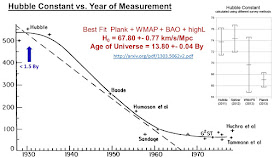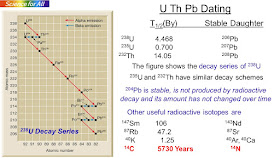In my seminar last week at Glasgow University I had described, from a physicist's perspective, how Radiometric Dating (RD) is used to determine the age
of the Earth and the Solar System and in that process provides an absolute time
scale for geological events. RD has
played an equally important role in establishing the Continental Drift theory
or Plate Tectonics on a firm footing.
What was amazing to realize is that the world’s oceans are continuously created
and destroyed and that the oldest ocean crust is merely 200 million years (My)
old. In contrast, continental crusts
were formed as the earth cooled 4550 million years ago and are not subject to
recycling like the oceanic crusts are. The
following two slides show the measured ages of the oceanic crusts:



The first slide is for the Atlantic Ocean while the second slide shows similar data for the oceans of the world. Youngest rocks in the crust lie along the mid-oceanic ridge where new crust is being created by extruding magma from the mantle of the Earth. As new magma is introduced, it collects over the older magma (now solidified) and slides down by gravity as shown in slide 3, on both sides of the ridge and creates the oceanic crust. The oldest oceanic crust is merely 180 million years old.
The question then is what causes the mid-oceanic ridge to extrude magma. The continental crust is transported, albeit very slowly, by the convection currents in the mantle and as the two continental crusts move apart, space is created for magma to leak through and create what becomes the mid-oceanic ridge. As magma solidifies, it forms igneous rock known as basalt which has a higher density (3 gm/cc). The continental crust, largely made of silicates has a density of 2.7 gm/cc. The oceanic crust, being heavier, subsides below the continental crust and creates a subduction zone, mixes with the mantle and melts. Some of the molten crust seeps through the cracks in the stressed continental crust and leak out as volcanoes. Such volcanoes form in subduction zones - 'Pacific Ring of Fire' is an excellent example of some of the regions where volcanoes occur (see slide).
.
.
Active volcanoes (red dots) define the Pacific Ring of Fire where they form along tectonic plate boundaries. Figure modified from USGS (Topinka, 1997).
The overall topology of an ocean floor might look as in the next slide. Sometimes the ridge may be high enough to stick out of the water level and form an island. Iceland is an example and it sits right on top of the mid-Atlantic ridge.
The region of the subduction zone, where the oceanic crust goes under the continental crust, there is a deep trench created and these are the places where the ocean has the greatest depths. In the Abyssal plain, sediments from the continent deposit and form a nice flat surface.
WHY CONTINENTS DRIFT - what causes them to move?
People had suspected for a long time that continents drift. The matching shapes of the continental boundaries were the first indications and were commented on by many scientists and others.
People had suspected for a long time that continents drift. The matching shapes of the continental boundaries were the first indications and were commented on by many scientists and others.
.
Alfred Wegener 1912-15 first proposed his theory of continental drift but could not provide a credible mechanism for causing this drift.
.
Wegener's theory essentially was that about 200 million years ago, all continents were joined together as a super-continent called Pangaea meaning 'all land'. Pangaea broke up into individual continents which drifted apart and now occupy their current positions.
There was a lot of evidence in the form of similar fossils, rock
formations and climate found in different continents that could not be explained by any other way except by assuming that all these continents were joined together at some distant past. Wegener's theory had firm empirical backing but the main question as to how the continents could move - what cases the movement - just could not be explained.
Naturally a great debate started in geology with many geologists in favour and equally large numbers against the idea of drifting continents. Arthur Holmes liked the theory and proposed that convection cells in the mantle of the Earth can provide such a mechanism. Earth's interior was not well understood in the 1930s and the idea met with great opposition and was to some extent ridiculed.
Holmes persevered with his theory but nothing really happened until the 1950s when firm evidence of sea-floor spreading became available and the reality of drifting continents could not be ignored. The evidence was in the form of magnetic zebra stripes that were mapped and found to be symmetrically placed on either side of the mid-oceanic ridge.
.
Naturally a great debate started in geology with many geologists in favour and equally large numbers against the idea of drifting continents. Arthur Holmes liked the theory and proposed that convection cells in the mantle of the Earth can provide such a mechanism. Earth's interior was not well understood in the 1930s and the idea met with great opposition and was to some extent ridiculed.
Holmes persevered with his theory but nothing really happened until the 1950s when firm evidence of sea-floor spreading became available and the reality of drifting continents could not be ignored. The evidence was in the form of magnetic zebra stripes that were mapped and found to be symmetrically placed on either side of the mid-oceanic ridge.
The formation of magnetic zebra stripes is interesting. Earth’s magnetic field has reversed many times over the planet’s history—with the magnetic north sometimes facing south, or vice versa, as it is today.




When
seafloor lava solidifies at the seafloor, its magnetic crystals are quenched in
alignment with Earth’s magnetic field, and the rocks’ magnetic “polarity” is
preserved.
Radio-isotope dating of oceanic crusts tells us accurately the time that a particular part of the crust was formed. It is then possible to calculate the rate at which oceanic floors have been increasing and continue to spread. This is shown in the next two slides:
These days, satellite observation of fixed points on the Earth allow us to measure the spreading rates very accurately and the data in the slides reflect these measurements.
We still have to address the mechanism of continental drift - or as it is now known - plate tectonics. There is a lovely set of slides, 147 in total, that really cover the subject in great detail. I shall briefly summarize it here.
Our earth started life as a molten sphere with chemical composition of the Solar Nebula. As the earth cooled, heavier metals (Iron and Nickel) sank to the bottom ( to the centre of the sphere), the lighter materials floated to form a layered structure (rich in silicon, oxygen, aluminium, calcium, potassium etc.). This is shown in the following two slides
Building on Arthur Holmes theory of convection currents in the mantle, Harry Hess developed the idea of sea-floor spreading in the 1960s. The following two slides summarize the situation
In 1965, John Tuzo Wilson put forward the theory of plate tectonics by suggesting that the Earth's crust is made of a number of rigid plates. Plate Tectonics is an interesting subject and it is easy to get carried away with writing pages. I shall not do it here and refer you to the web site that has a detailed very readable description of plate tectonics.














































